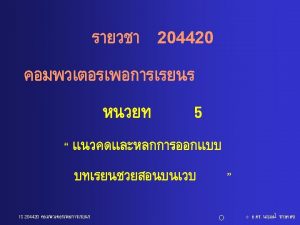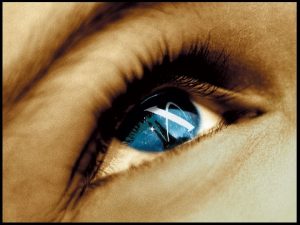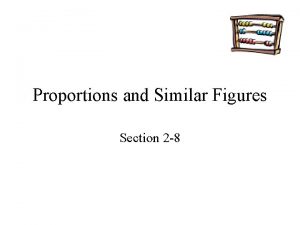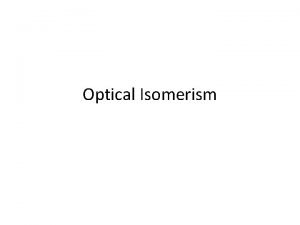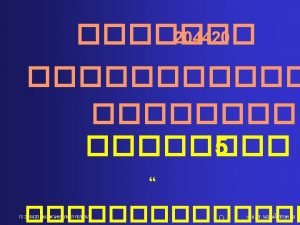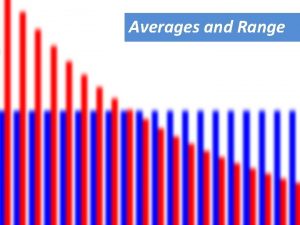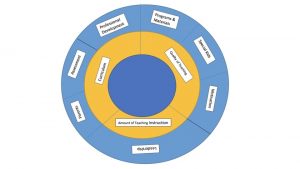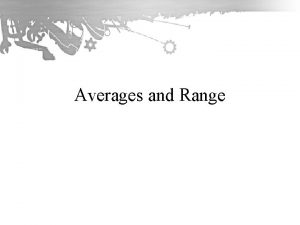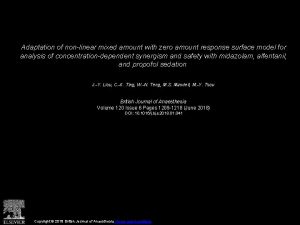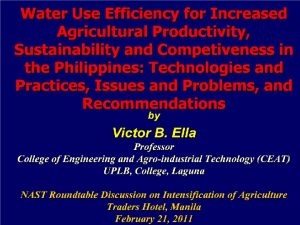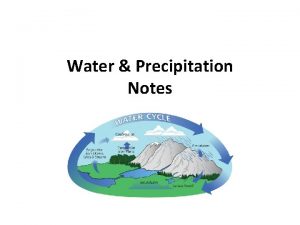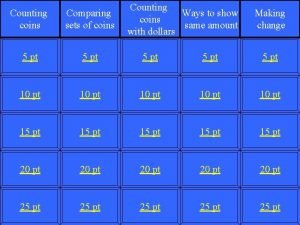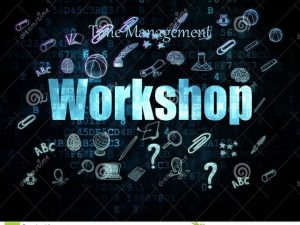Water Chapter 20 There is the same amount





























- Slides: 29

Water Chapter 20 There is the same amount of water on Earth as there was when the Earth was formed. The water from your faucet could contain molecules that dinosaurs drank!

What we will cover • • Discussion of Lab Uses for Water (20. 1) Water Resources (20. 2) Water Treatment (20. 3)

Lab Discussion • What did you learn? • Why do you think we test p. H? – City water is adjusted to ~p. H 7 • Why is chlorine added to drinking water? – To kill bacteria, germs, and control algae • What is hard water? – Contains a lot of calcium and magnesium – How would we know we have hard water without testing it?

Definitions • Potable water: Safe for drinking • Unpotable water: Not safe for drinking

20. 1 Uses for Water • Residential Use – Personal hygiene and home cleaning • • Clothes washing Showering Machine dishwashing Shaving Brushing teeth Toilet flushing Washing hands and face 140 -170 L 75 -80 L 56 -60 L 39 -58 L 19 -39 L 16 -21 L per flush 4 -8 L

Uses for Water • Residential Uses – Personal hygiene and home cleaning – Drinking and Cooking – Outside the home • • ? ? ? ? Watering the lawn Gardening Car washing Recreational activities (i. e. swimming pool)

Uses for Water • Industrial Use – – Transport goods Dispose of Wastes Power source Coolant • Agricultural Use – Irrigation: bringing water to an area for the use of growing crops • • Flood Furrow Overhead Subirrigation

2) 1) 3) 1) Furrow Irrigation 2) Flood Irrigation 3) Overhead Irrigation


Effects of Water Use on Ecosystems • Building dams • Draining swamps • Removal of water from natural sources – Effect food chains, forcing those that feed on organisms that live in water to migrate (such as birds)

Time to Fill in your Worksheet!! • Define potable water: – water safe for drinking • Define unpotable water: – water not safe for drinking • Define irrigation: – the process of bringing water to an area for use in growing crops

Time to Fill in your Worksheet!! • Three main categories in which water is used – Residential • Name two ways – Industrial • Name two ways – Agricultural • Name two ways • Name three ways human water use effects ecosystems – Dams, draining swamps, removal of water from natural sources

20. 2 Water Resources • Natural storage of water as a resource – Surface water • Streams, lakes, ponds – Ground water • Aquifers

AQUIFERS Water Table: top layer of the zone of saturation where groundwater collects and saturates the bedrock, (where you withdraw your well water)

Water Resources Problems • Overdraft – When a body of water is drained faster than it is filled

Two problems associated with overdraft • Saltwater intrusion • Subsidence

Time to Fill in your Worksheet!! • What is surface water? – Water aboveground in streams, lakes, and ponds • What is ground water? – Water within porous or jointed bedrock, stored in aquifers • Define water table. – The top of the zone of saturation where groundwater collects and saturates the bedrock • What causes overdraft? – Removal of water from a body of water faster than the body of water is filled

20. 3 Water Treatment Now fill in as we go… • Did you know…? ? Nearly 97% of the world’s water is salty or otherwise undrinkable. Another 2% is locked in ice caps and glaciers. That leaves only 1% for all of humanity’s needs —all its agricultural, residential, manufacturing, community, and personal needs.

20. 3 Water Treatment • Why is fresh water in many parts of the world not potable? ? – Ex: South America, Mexico, China, and parts of Africa Bacterial and chemical contamination, not sufficient technology available to purify the water • When visiting these countries, should you pour your bottled water (clean water) over ice? Why or Why not? ? No! Ice is made from the unpotable water!! • What is limited by access to fresh water? Population Growth


(1) Find source of water and withdrawal amount for treatment (usually a constant withdrawal for municipalities)

(2) Sedimentation: Large matter falls out (leaves, sticks, big dirt particles); Coagulation: Chemical additives (coagulants) added to cause fine particles to clump together and settle out

(3) Filters: Vary by treatment plant, but at least 1 m thick layer of sand to trap what didn’t fall out during sedimentation and coagulation

(4) Aeration: exposure of water to air and sunlight to add oxygen as a purifying agent Sterilization: Ozone is a strong sterilizer, but often chlorine is used because it is less expensive

(5) Storage Reservoirs: Several types, and generally located at the highest point of the distribution plane

(6) Distribution to consumers

Alternatives • Salt water? – YES! Desalination (removing of the salt)…expensive, but some states are resorting to this! • Wells • Cisterns

Time to Fill in your Worksheet!! • What are the six main steps in water purification/water treatment? 1. 2. 3. 4. 5. 6. Locate and withdrawal from source Sedimentation and coagulation Filtration Aeration and Sterilization Storage Distribution to consumers

Time to Fill in your Worksheet!! Label your water treatment diagram on the back of your worksheet 2) 1) Sedimentation & Coagulation Locate & withdrawal from source 6) Distribution 3) Filtration 4) 5) Storage Aeration & Sterilization
 Water and water and water water
Water and water and water water Same place same time
Same place same time Same place same passion
Same place same passion Similar
Similar Similar figures have the same but not necessarily the same
Similar figures have the same but not necessarily the same Cis trans vs e z
Cis trans vs e z A paved blacktop parking lot was built
A paved blacktop parking lot was built Hát kết hợp bộ gõ cơ thể
Hát kết hợp bộ gõ cơ thể Bổ thể
Bổ thể Tỉ lệ cơ thể trẻ em
Tỉ lệ cơ thể trẻ em Voi kéo gỗ như thế nào
Voi kéo gỗ như thế nào Glasgow thang điểm
Glasgow thang điểm Chúa yêu trần thế alleluia
Chúa yêu trần thế alleluia Môn thể thao bắt đầu bằng từ chạy
Môn thể thao bắt đầu bằng từ chạy Thế nào là hệ số cao nhất
Thế nào là hệ số cao nhất Các châu lục và đại dương trên thế giới
Các châu lục và đại dương trên thế giới Công thức tính thế năng
Công thức tính thế năng Trời xanh đây là của chúng ta thể thơ
Trời xanh đây là của chúng ta thể thơ Mật thư tọa độ 5x5
Mật thư tọa độ 5x5 Phép trừ bù
Phép trừ bù độ dài liên kết
độ dài liên kết Các châu lục và đại dương trên thế giới
Các châu lục và đại dương trên thế giới Thể thơ truyền thống
Thể thơ truyền thống Quá trình desamine hóa có thể tạo ra
Quá trình desamine hóa có thể tạo ra Một số thể thơ truyền thống
Một số thể thơ truyền thống Cái miệng xinh xinh thế chỉ nói điều hay thôi
Cái miệng xinh xinh thế chỉ nói điều hay thôi Vẽ hình chiếu vuông góc của vật thể sau
Vẽ hình chiếu vuông góc của vật thể sau Nguyên nhân của sự mỏi cơ sinh 8
Nguyên nhân của sự mỏi cơ sinh 8 đặc điểm cơ thể của người tối cổ
đặc điểm cơ thể của người tối cổ

